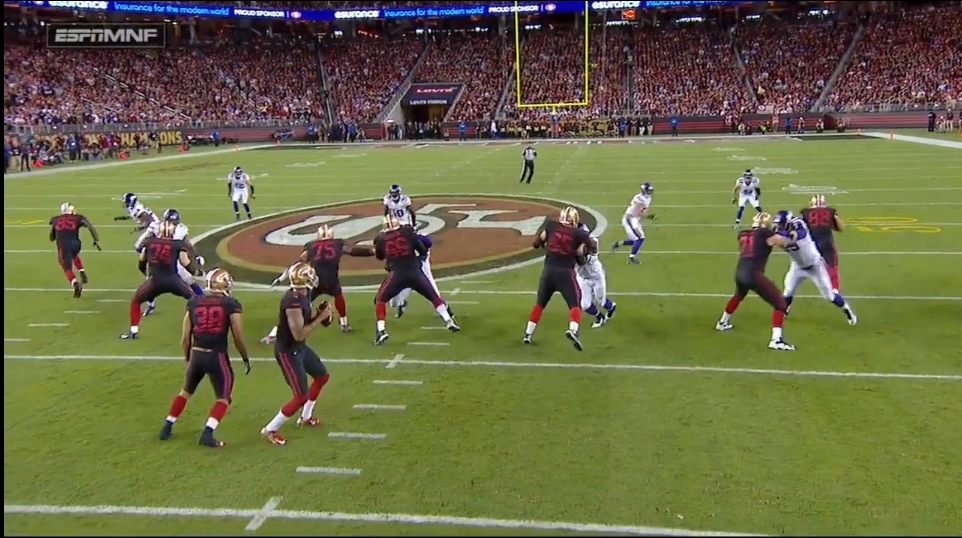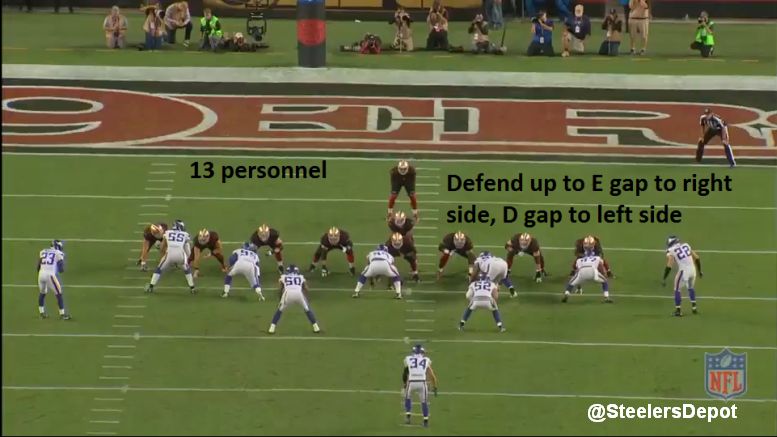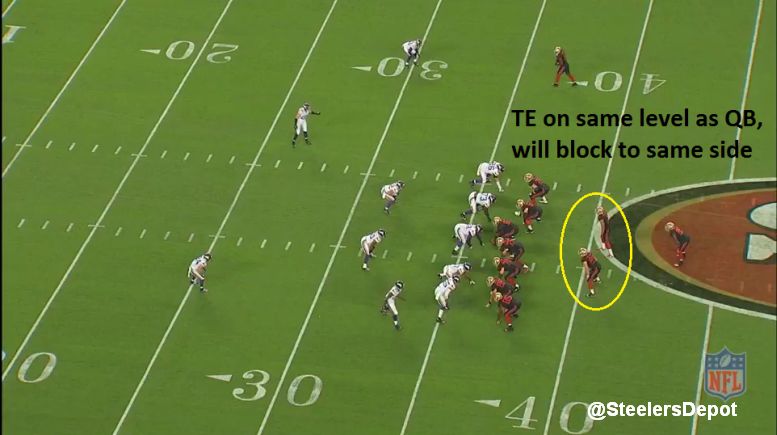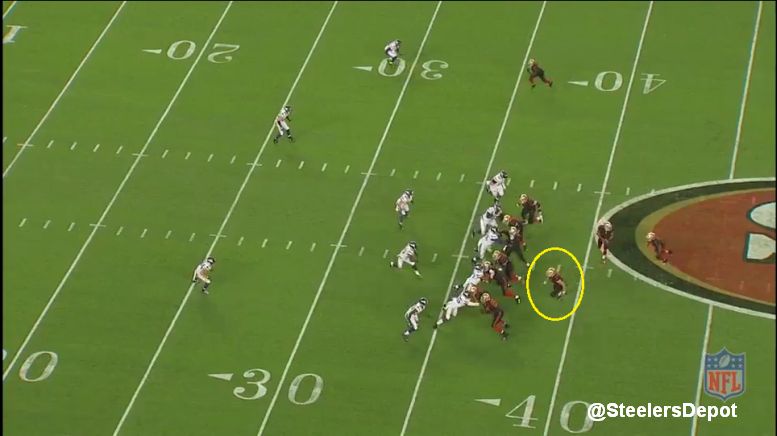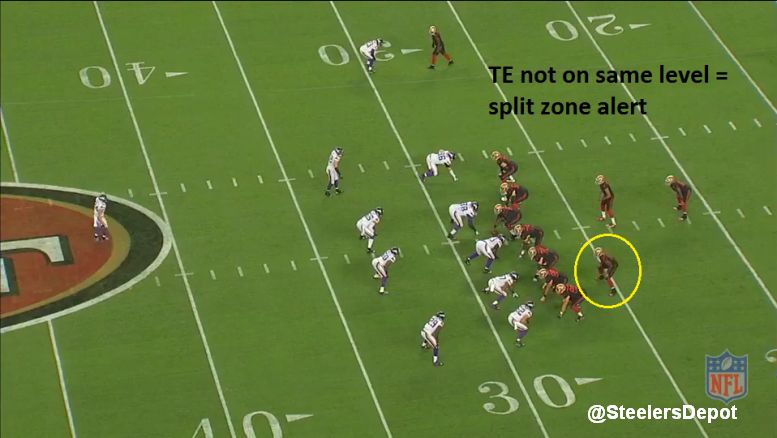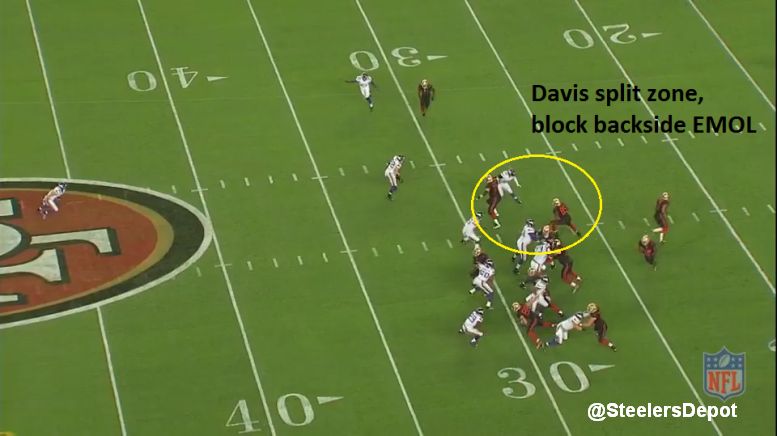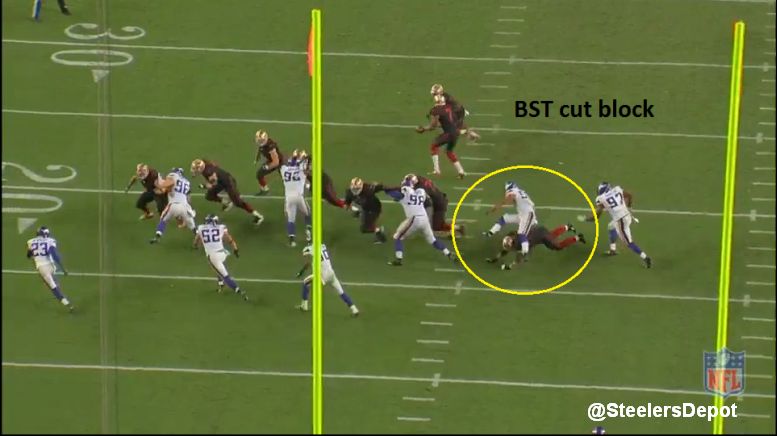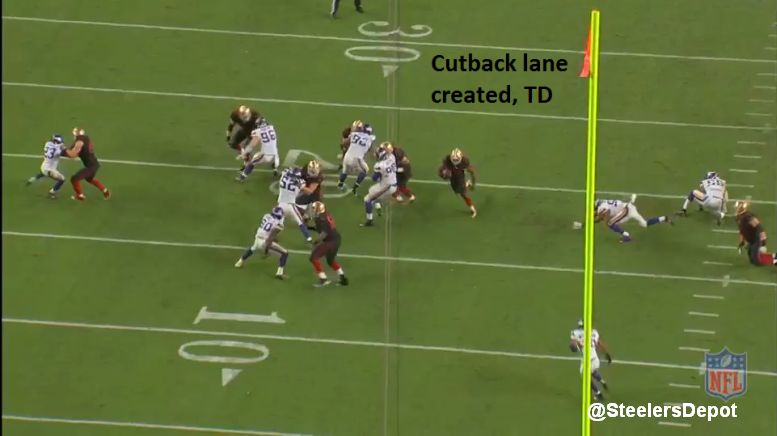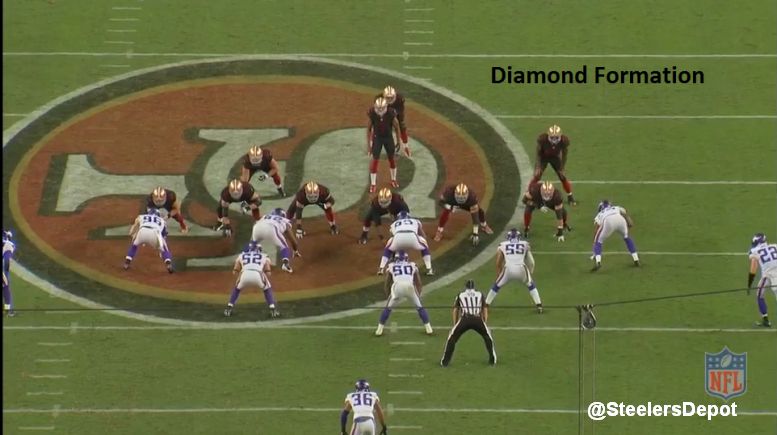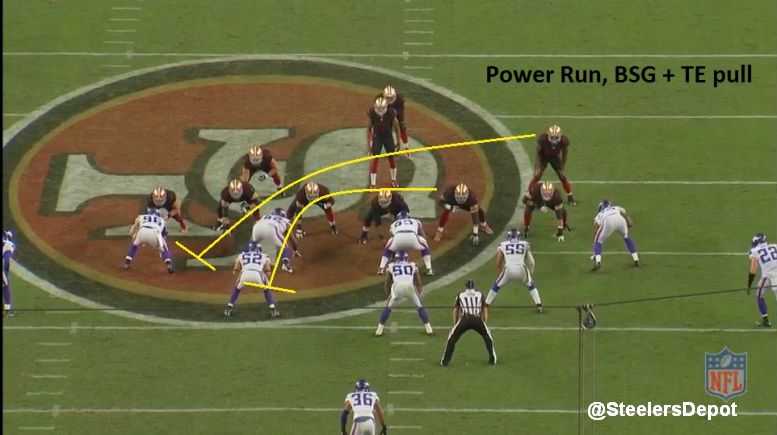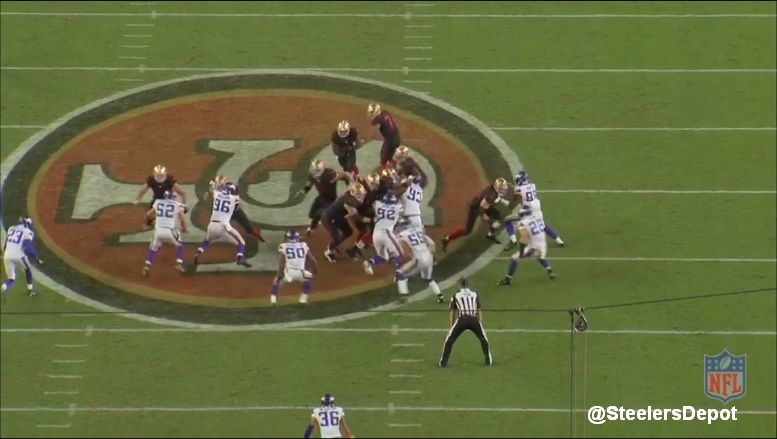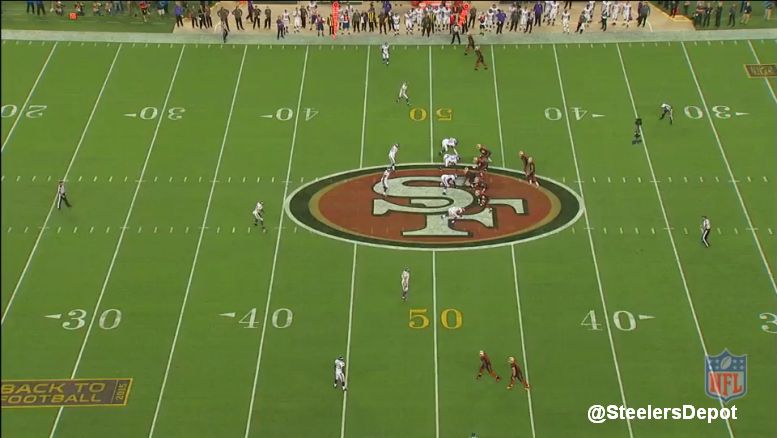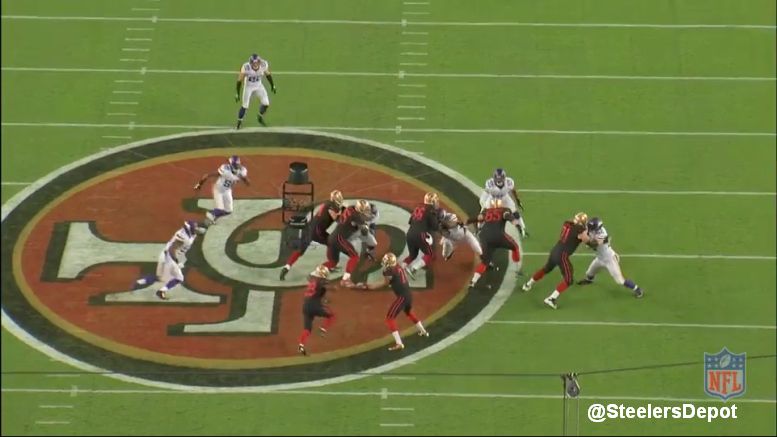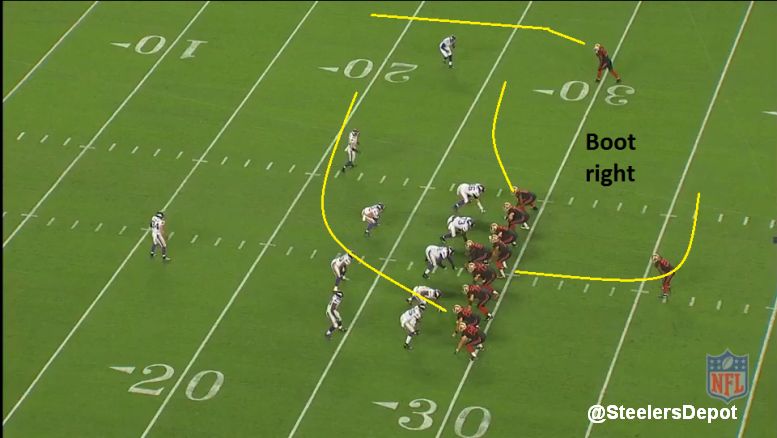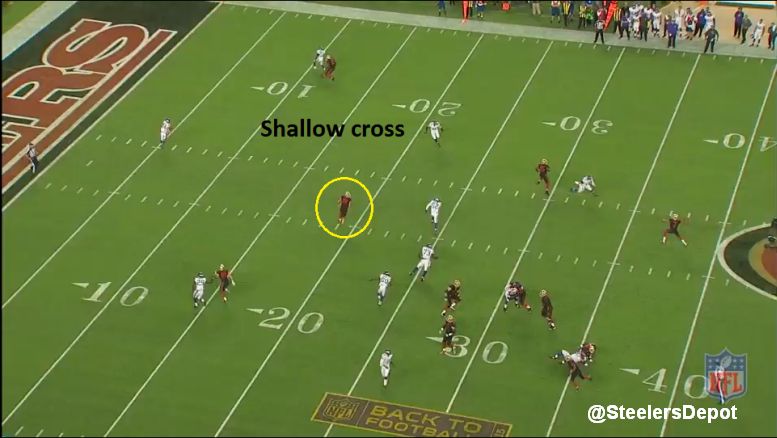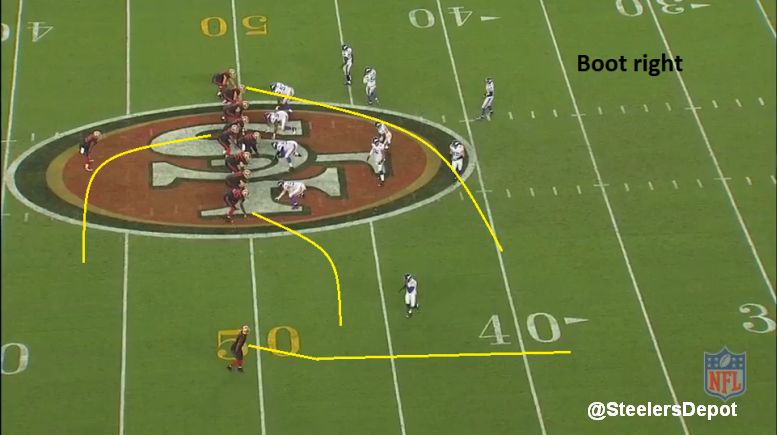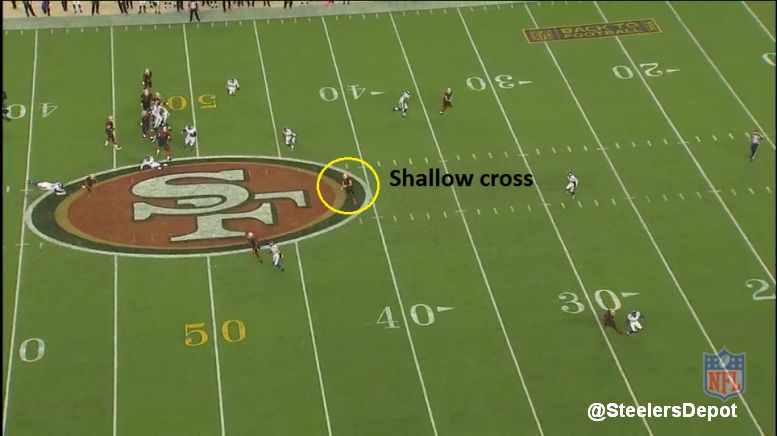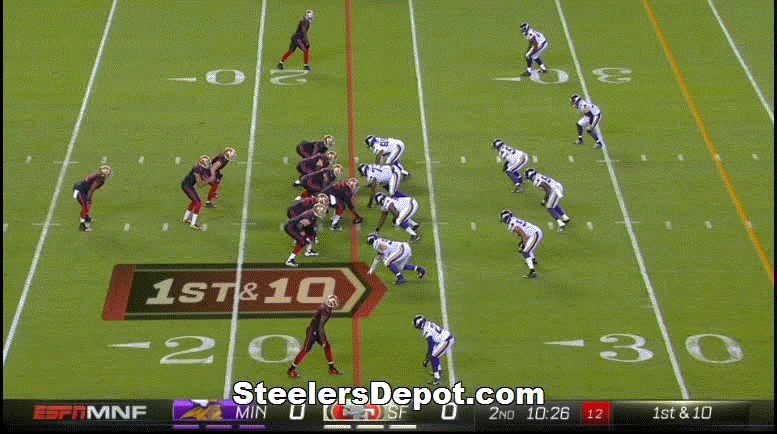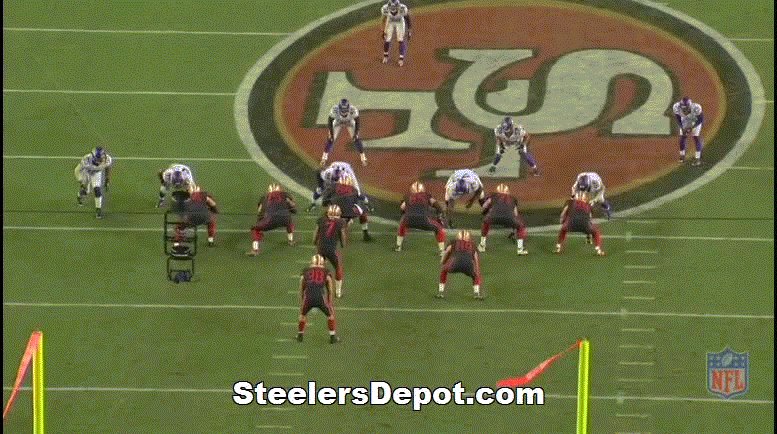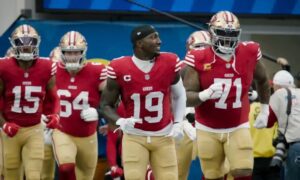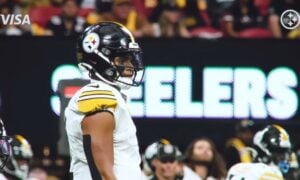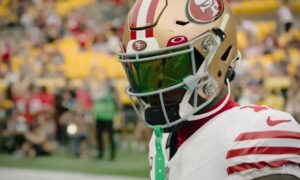This year, Jon Ledyard and myself will be collaborating our scouting reports. We’ll play to our strengths – he’ll be focusing on the individuals while I’ll be looking at overall scheme. These reports will be broken down into two articles, one for offense and one for defense.
Our reports for the San Francisco 49ers offense.
ALEX’S SCHEME REPORT:
San Francisco 49ers Run Game
It’s their meat and potatoes. I only skimmed 2014 tape, and though the team has undergone so many changes, it’s remarkable the personnel shift. In a word, the 49ers are much more compressed in 2015. They’ve molded several strong tight ends, with such a surplus they traded two away in the preseason (Asante Cleveland to New England, Derek Carrier to Washington) and though they added Torrey Smith, lack depth at wide receiver.
They are a 12 and 13 personnel heavy offense, as indicated by Dave and Jon. Two tight ends on over 75% of their snaps Monday night against the Minnesota Vikings.
They lack the vertical threat the Patriots had, and they won’t spread you out and flex their tight ends the same way either, but they present similar challenges in the run game. Force defenses to account for a lot of gaps, the D and the F gaps. Two and three tight end surfaces are common and you’re going to have to be sound in your run fits defensively. The 49ers’ offensive line is physical and tenacious and the Steelers are going to have to match that.
In those linear sets, without a tight end in the backfield, the 49ers run a mostly zone game. If Monday is any indication, they run as much outside zone as any team in the league. They will get you running laterally, force you down the line to defend the edge, combat your edge defenders and defensive backs with their strong, physical tight ends – and that’s a collective group with Vernon Davis, Garrett Celek, and Vance McDonald – and then cutback on you once you start cheating and flowing down the line. Carlos Hyde, as Jon has pointed out, is a dangerous combination of vision, power, and elusiveness when left one-on-one. He’s a handful.
The 49ers almost exclusively run to the strength of the formation. Against the Vikings, they ran to the FB side/TE strength on 22 of 25 runs. It is worth, noting, one of the exceptions turned into an 18 yard Hyde run. Nice tendency breaker.
They do not have a hash tendency. When on the left hash, the 49ers had a 58.8/41.2 right to left run split. On the right hash, they had a 57.1/42.9 split. Neither stick out, especially when you consider the small sample size of 17 and 14 runs, respectively.
The 49ers will run their pistol without a fullback or they’ll often place Bruce Miller sidecar next to Colin Kaepernick. Miller, a bruiser himself, will line up out of a two and three point stance though I didn’t identify – or weren’t smart enough to catch it – a difference in what he did out of either.
They’ll also motion tight ends sidecar, too, doing so several times to open up the game. Those tight ends block the same way as the side they’re on (to the right, block right) if they’re on the same level as the QB. If they are on a different level, again in the limited sample size I have, they will cross the quarterbacks face on a split zone concept. In the first set of clips, the TE blocks the same way. In the second, there’s Vernon Davis on the second play of the game. Motioned side car but on a different level, in front of, Kaepnerick. Davis blocks the backside EMOL on that split zone concept. He’s lined up on a different level so he can cross the QBs face without interfering with the mesh point.
On the 49ers inside zone runs, they cut block with the backside tackle. Very effective and opened up some huge cutback lanes for Hyde. Joe Staley is an athletic left tackle and a powerful cut blocker who can take your legs out. Have to stay on your feet and squeeze that cutback lane to keep Hyde down the line.
San Francisco ran a diamond formation six times Monday night. That’s a full-house look with three players in the backfield along with the QB. They averaged 7.2 yards per play off it including runs off nine, one, nine, and five. This is where a lot of their power concepts came from, gap runs with the backside guard pulling. Diamond formations gives the offenses more blockers while staying balanced, able to run to the defense’s weakside no matter how they try to defend it.
The 49ers do run RPOs, as seemingly every team in the NFL does. In some short-yardage situations, they will spread you out in a 2×2 look with wide splits to create a six man box with an easy inside option or bubble if need be.
I don’t have it pictured but they had a 3×1 set with receivers split out wide, though not as extreme as shown below, on a 3rd and one. Empty the box and run inside zone.
San Francisco’s Passing Game
It’s hard to get a read on it because they just don’t do it much. They love their boot game, booting six times Monday night. All boots to the right for the right-handed quarterback.
They did so four times on 1st and 10 and five times on the left hash. Good tendency alert there so look for that Monday. 1st and 10 on the left hash should be a boot alert.
The only exception to the hash came on a 3rd and 1, when they booted off the right hash for a quick gainer and conversion. With the boot and the RPO with wide splits mentioned in the run game section, you can tell that for a conventional offense, they’ll throw in wrinkles in short-yardage situations like that, as opposed to running full-steam ahead.
The six boots averaged 9.5 yards per play and completed five of the six passes. The longest gain was a 20 yard reception to Celek.
Each boot has the Steeler-killer shallow cross either from the TE on a Y cross or once, a receiver. Sometimes it’ll create a sail concept with the playside boot receiver running vertically, the backside TE on the shallow cross, and a frontside receiver leaking out. A levels concept but it appears the shallow cross is the first read.
The Cleveland Browns lived off this play with Jordan Cameron last season. Hard not to be worried.
The 49ers’ receivers didn’t get very involved Monday night. Anquan Boldin was the only receiver to record more than two receptions and 11 yards.
San Francisco’s Special Teams
For the offense, we’re only concerned with the return and kicking game. The other units will be covered in the defensive report.
As you probably remember, the 49ers had a field goal blocked on their first possession. A protection mistake of not having enough numbers to the right side, accounting two players to block three defenders. The blocker split the right wing and right tackle. That is an area to stress, and you want to try to overload sides to see if the 49ers will adjust, but I imagine they’ll take care of it after such an egregious mistake that cost the team three points.
Honestly, with such dark jerseys, it was difficult to determine numbers. As return men, Bruce Ellington served as the kick returner with Quinton Patton – a favorite of mine coming out of Louisiana Tech but hasn’t materialized in the NFL – serving as the upback. Jarryd Hayne was the team’s starting punt returner but after a muff and misjudge of another, he was replaced by Ellington. If Hayne trots back out there again, he’s a powerful guy who seeks contact. Conversely, Ellington is a speedster.
JON’S INDIVIDUAL REPORT:
The San Francisco 49ers may have the most unique offensive approach in the NFL, mixing old school power football concepts with extremely modern wrinkles like zone reads and RPOs. As I tweeted out yesterday, the 49ers ran 71 plays (counting penalties) against the Vikings on Monday night, operating out of 12 personnel 20 times, and out of 13 personnel 30 times. That’s a ton of multi-tight end sets, probably more than any other team in football.
But no one can say the Niners don’t have the right players for the job, as the trio of Vernon Davis, Garrett Celek, and Vance McDonald are all excellent run blockers, especially in space. Many think of Davis as the most athletic tight end in football, which he may be, but Davis has also become a selfless and highly motivated blocker in San Francisco.
Works to the edge defender, safety Andrew Sendejo, then shows great presence of mind to get off that block and accelerate to the second level, where he knocks Xavier Rhodes back too. Davis isn’t a mauler, but he understands angles and technique, big keys to being an excellent run blocker.
McDonald might be the best blocker of the trio, as the former second-rounder even sees some reps as a lead-blocking fullback. McDonald is the outside left in-line tight end here (#89), tasked with the responsibility of kicking out edge defender Chad Greenway, which he does with excellent arm extension and leg drive.
Celek is also a solid blocker, but he will have trouble sustaining against bigger defenders. Here is Vikings rookie defensive end Danielle Hunter shedding him with ease at the point of attack, albeit missing the tackle.
Celek is a really underrated receiver however, who shows good hands and a strong football IQ in his patterns.
Fullback Bruce Miller? Yeah he’s a load too, especially in space.
The offensive line is an outstanding run blocking unit, but not ideal in pass protection. That said, many of San Francisco’s pass plays are rollouts, play-action fakes, and RPOs, so the offensive line’s burden is eased a bit there in pass protection.
Joe Staley is the leader of the group, a nine-year veteran who is one of the best left tackles in the game. He’s an excellent fit for San Francisco’s offense, as he can combo block and get to the second level with the best of them. This is a gorgeously blocked play in general, but watch Staley fire off the ball to pin middle linebacker Gerald Hodges inside.
That’s textbook blocking, from the get-off, to the technique, to the nasty little shove at the end. Staley does many different things well in the run game; pulling into space, working to the second level, and even cut-blocking on the backside. Check out how violent this cut is from Staley on Anthony Barr.
Essentially eliminates both backside defenders and allows an easy path for Carlos Hyde to romp untouched to the end zone. The Steelers backside defenders will need to squeeze these gaps to force Hyde play side and into the teeth of the defense.
Hyde is a marvelous blend of quickness and physicality as a runner, with the size to break arm tackles, and the balance and agility to make defenders miss. He’s far more elusive than he was at Ohio State, and has toned up considerably in the NFL as well. Hyde is also a great receiving option out of the backfield, and has shown the ability to pass protect when needed. Sound familiar?
The 49ers receivers are used much more seldom than most teams in today’s NFL, but Anquan Boldin and Torrey Smith are still good complements to each other. Neither will do much for your fantasy team, but Boldin is still tough to bring down after the catch and will attack the football in the air. He is aging however, and really struggles to get separation on many of his patterns.
Smith is the opposite, capable of stretching the field and separating vertically, but isn’t much of a dynamic threat in other ways. He never became what Baltimore envisioned, and I don’t know that I see his fit in San Francisco. They ask their wide receivers to block a good bit, something Smith still struggles with.
Quinton Patten and Bruce Ellington were the team’s only other receivers to dress on Monday night. The 49ers ran 11 personnel (3WR sets) on just eight snaps against Minnesota, so Patten is seldom used in offensive coordinator Geep Chryst’s plans.
Vernon Davis is probably the team’s top receiving threat, although he was used very sparingly last year. Davis can stretch the field as well as any tight end in the game, and has become a strong route runner over time. He whipped rookie Eric Kendricks on this deep curl Monday night, throwing a head-and-shoulders fake outside before breaking inside.
Davis is on the far right side of the screen in the slot, aided greatly by a well-timed throw from Colin Kaepernick as well.
Kaepernick is still largely inconsistent at quarterback, but very effective with his legs and at throwing on the move. Very few signal callers can boast his natural arm strength and velocity, but his delivery is still elongated and his release point is inconsistent. He’s learning to throw with touch when given time and space, but ask him to operate from the pocket and his efficiency goes way down.
Tries to hit Reggie Bush on the wheel route, which is open initially, but the throw is late and way off target. This is consistently what you get when Kaepernick is forced to make throws from the pocket, especially if his protection is crumbling and the defense has him contained. His first instinct isn’t always to scramble, but he definitely is more comfortable on play-action rollouts and bootlegs that get him in space and give him easy target options away from pressure.
This was the Niners first passing play of the game, one of two PA rollouts they called on their first drive. Kaepernick’s quarterback rating in these situations last year was over 100 if I remember correctly, so the 49ers like to get him in these situations early and often and build his confidence level from there. Simple, easy progressions to work through, and plenty of space and time to work with.
Of course, everything San Francisco does is predicated on being able to run the football well and get themselves in 2nd/3rd-and-manageable situations. They don’t care about scoring a lot of points, and hitting the big play isn’t their priority. They want to control the ball, wear down your defense, and continually keep opponents guessing with a variety of different personnel looks. San Francisco might only take one or two shots 25+ yards downfield all game, and those will likely just be to keep defenses honest. I’m sure they’ll have some different wrinkles to show Pittsburgh in Week 2, but their intentions will be no secret. They want to run it down your throat, get defenders to compromise their assignments to stop the run, then use your tendencies against you.
Pittsburgh will need to be much more disciplined defensively then they have been against play-action over the past couple years. The Cleveland Browns killed the Steelers with a lot of the same concepts last year, as did the New York Jets (amongst other teams I’m sure). Against the run, backside defenders must keep their feet and contain runners with assignment-sound play and alertness. The 49ers are brutal enough playside at the point of attack, give them cutback lanes, and your defense is in for a long night.
The real key to slowing down San Francisco is to get an early lead and force them out of their comfort areas on offense. If the 49ers can’t control the game, and if they have to make up a big deficit, you’ve got them where you want them. Force Kaepernick to become a pocket passer, contain him in there, and your defense has created a winning formula. Easier said than done perhaps, but such is the task Pittsburgh must accomplish on Sunday afternoon.
On special teams, kicker Phil Dawson had one of his worst seasons in awhile last year, but still converted over 80% of his field goal attempts. He was on a stretch from ’11-’12 where he made 14-15 kicks from 50+ yards out, but over the past two seasons that number fell to 10-15, which is still pretty good. Hasn’t missed an extra point since 2009, and is 41-44 from 30-39 yards over the past seven seasons. Not too shabby for a 40 year-old kicker.
Dawson did have a 28-yard field goal blocked against Minnesota, the result of an overload by the Vikings to attack the right side of the 49ers line. The issue was a missed block up front on an overload by the Vikings, nothing Dawson did.
Jarryd Hayne began the game against Minnesota returning punts, but after a first quarter muff, Bruce Ellington took his place. The South Carolina product tightroped down the left sideline for a touchdown on one punt return in the second quarter, but a block in the back brought it back. Ellington has tremendous speed once he gets into the open field, so Pittsburgh will need to keep him contained at all times on Sunday.

